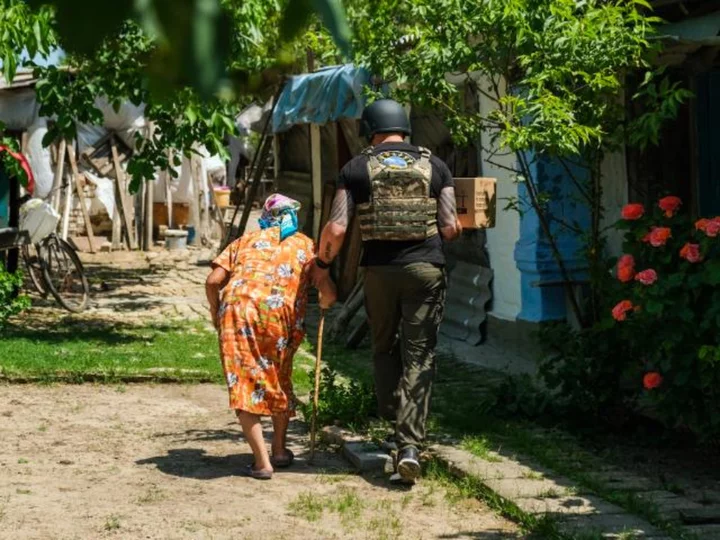Deep inside a makeshift bunker, residents of Orihiv await an aid delivery while artillery shakes the ground above.
"It's comfortable here," 72-year-old Olga Shumska says, unfazed by the commotion outside. The town in the Zaporizhzhia region sits just five kilometers away from a frontline where Ukrainian forces have been making a recent push.
"I'm not afraid, I'm used to it and I don't want to go anywhere from here. I tell myself that soon the war will end and we will live normally."
But this is far from normal. Months of shelling have destroyed most of the town's infrastructure, leaving Orihiv without electricity, gas or water.
"It is very dangerous. We had people killed and wounded and there is a lot of destruction," Shumska explains. "In August last year my house was also destroyed."
Most of the town's 1,400 remaining residents, down from a pre-war population of 14,000, now live in basements and these bunkers — so called 'invisibility centres' — are the only place they are able to shower, do laundry, charge their phones or eat a warm meal.
"We're here almost every day, because it is safe here, our friends are here," Shumska's neighbour Nina Sokol says. "Tomorrow there will be a church service until noon. So we'll be here for 3 to 4 hours and after the service, we will have dinner and go home."
An unfathomable existence for most, but not for Sokol.
"What is there to be afraid of?," the 71-year-old asks. "There are no two deaths. There is only one death."
The trick, she says, is to try and delay it, an increasingly difficult task for the residents of Orihiv, who rely on deliveries from aid agencies to survive.
Today they're getting a box of long shelf life foods that should last them for a week or two. But deliveries like these are not easy.
"Orikhiv is one of the most dangerous places in Zapoprizhzhia region," says Vitaliy Kubushka from the Global Empowerment Mission (GEM) and the Howard Buffet Foundation, the organisation behind the aid. "The town is shelled every 24 hours."
And with the Zaporizhzhia frontline becoming more active because of an anticipated Ukrainian counteroffensive, aid deliveries may become more rare.
The Zaporizhzhia front
For most of the 60 km journey down from Zaporizhzhia to Orihiv, you'd be forgiven for forgetting Ukraine is a country at war. The idyllic route is flanked by stunning yellow colored meadows, interrupted only by the occasional line of trees.
But on the approach to Orihiv, the sense of danger starts to creep in.
The bucolic fantasy fades away as the abrupt, repetitive swoosh of a Ukrainian grad firing rockets towards Russian positions break the silence.
The Ukrainian military has built somewhat of an exclusion zone around the Zaporizhzhia front, hoping to retain the element of surprise as it continues to probe Russian defenses along the Southern front.
It has also encouraged civilians not to share any photos or videos of military operations, releasing a slick video ending with the line "plans love silence." Journalists are also rarely allowed through the checkpoints down south.
Once through, the military presence is felt -- and heard -- all around the region, but most of the hardware is hidden away from prying eyes and Moscow's sights.
Activity in the region suggests Ukrainian forces have begun probing attacks on Russian positions, but the videos shared by the Ministry of Defense in Moscow suggest Kyiv may be facing more resistance than initially anticipated.
The footage purports to show Western donated armoured vehicles -- including German-made Leopard 2 tanks -- seemingly destroyed by Russian forces. CNN has been able to geolocate the videos to the Zaporizhzhia region but is unable to verify when they were shot.
"We will be celebrating victory"
Down in the school basement, Shumska and Sokol pack their food boxes. They bring them up and out of the bunker, despite calls by volunteers for people to take shelter after a shell lands nearby.
With their age comes frailty, but, they say, wisdom too. And nothing happens around town without them being well aware of it, even if that is a top-secret Ukrainian counteroffensive.
"Our soldiers, it seems they all went for the counteroffensive," Sokol says, longing for the day she can once again see her relatives, who are stuck inside Russian-occupied territories.
"They are already starting to push [the Russians] away from us," she says. "They will push them step by step, until they drive them out. Until there is a complete victory of Ukraine."
Shumska, more measured, says she is only praying for a win.
"I only hope that we will win and are able to live on our land, that we win and live freely," she says.
She straps the food box to the back of her bike and -- just before she cycles away -- Ukrainian forces somewhere outside of town are heard firing a shell towards Russian positions.
Unfazed but slightly emotional, with a sparkle in her eye, she says one last thing: "Come back soon, we will be celebrating victory."

